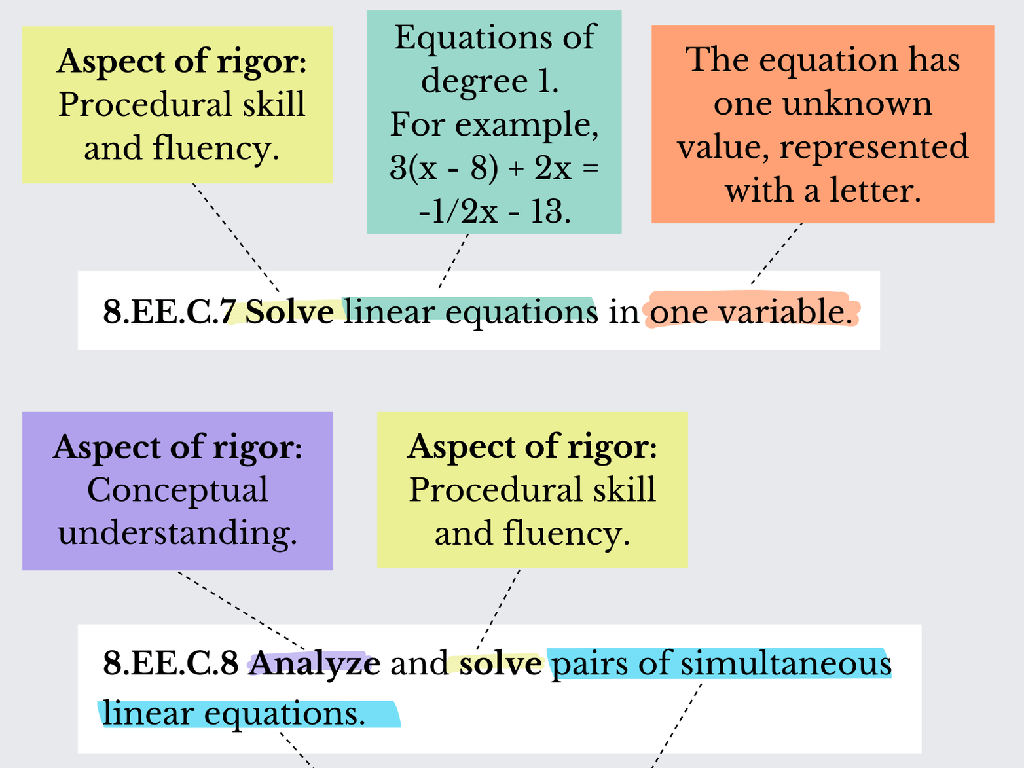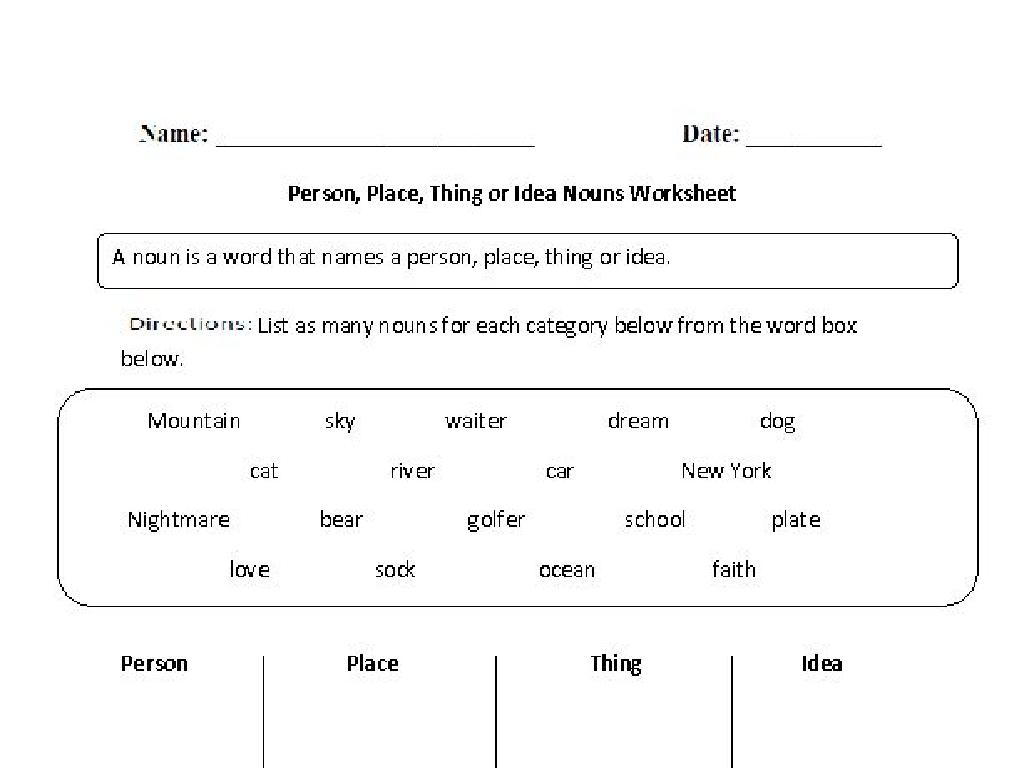Interpret Points On The Graph Of A Linear Function
Subject: Math
Grade: Eighth grade
Topic: Linear Functions
Please LOG IN to download the presentation. Access is available to registered users only.
View More Content
Interpreting Points on Linear Function Graphs
– Define linear functions
– A linear function has a constant rate of change, represented by a straight line
– Explore real-life applications
– Used in budgeting, speed, and more
– Today’s goal: interpret graph points
– Understand the meaning of any point (x, y) on the line
– Practice with examples
– Use given graphs to identify points and their meanings
|
This slide introduces students to the concept of linear functions and their significance in both mathematics and real-world scenarios. A linear function is characterized by a straight line graph, and each point on this line represents a relationship between two variables. Real-life applications include calculating expenses over time, determining speed, or predicting trends. Today’s objective is to ensure students can interpret specific points on a graph of a linear function, understanding what each coordinate pair represents in context. Provide examples of linear graphs and ask students to identify the meaning of particular points, reinforcing the lesson with practical exercises.
Understanding Linear Functions
– Define a linear function
– A function with a constant rate of change
– Equation of a line: y = mx + b
– Standard form where m is slope, b is y-intercept
– Components: Slope (m)
– Slope (m) measures steepness or incline
– Components: y-intercept (b)
– y-intercept (b) is where the line crosses the y-axis
|
Introduce the concept of a linear function, emphasizing its constant rate of change, which is visually represented as a straight line on a graph. Explain the equation of a line, y = mx + b, where ‘m’ represents the slope, and ‘b’ is the y-intercept. The slope indicates the steepness of the line and the direction it goes (uphill/downhill). The y-intercept is the point where the line crosses the y-axis, indicating where the function starts when x is zero. Use examples to illustrate how changing ‘m’ and ‘b’ values affect the line’s appearance on the graph. Encourage students to think of real-life situations that can be modeled by linear functions, such as speed or cost over time.
Graphing a Linear Function
– Plot the y-intercept
– Start at the y-axis where the line crosses
– Use the slope for next point
– From y-intercept, apply rise/run to locate another point
– Draw a line through points
– Connect the dots with a ruler for accuracy
– Interpret the graph
– Understand how the slope and y-intercept define the line’s path
|
This slide is aimed at teaching students how to graph a linear function step-by-step. Begin by plotting the y-intercept, which is where the line crosses the y-axis. Next, use the slope, which is the ratio of the vertical change (rise) to the horizontal change (run), to find another point on the graph. Once two points are plotted, use a straight edge to draw a line through them, extending it across the graph. Emphasize the importance of accuracy in plotting points and drawing the line. Finally, discuss how the slope and y-intercept determine the direction and starting point of the line, respectively. Encourage students to practice by graphing multiple functions with different slopes and y-intercepts.
Interpreting Points on a Linear Graph
– Each point (x, y) tells a story
– Consider (x, y) as a specific event or condition in a scenario
– ‘x’ changes impact ‘y’
– If ‘x’ increases or decreases, observe how ‘y’ responds
– How to find coordinates
– Use the graph to locate (x, y) and write them down
– Significance of coordinates
– Understand what these points mean in real-world situations
|
This slide aims to help students grasp the concept that every point on a graph represents a unique situation or event. By analyzing how alterations in the ‘x’ value influence the ‘y’ value, students can understand the relationship between variables in a linear function. Teach them to accurately find and write down the coordinates from a graph. Emphasize the importance of interpreting these coordinates within the context of real-life examples, such as distance over time or cost per item, to make the data more relatable and meaningful.
Graphing Real-World Linear Functions
– Graph a real-world problem
– Example: Graphing a car’s journey over time
– Interpret points within context
– Each point represents a position at a specific time
– Comprehend slope significance
– Slope shows speed: steepness indicates how fast the car travels
– Relate y-intercept to scenario
– Y-intercept is the starting point of the car’s journey
|
This slide aims to help students apply their understanding of linear functions to real-world scenarios. Begin with an example, such as graphing a car’s journey over time, where the x-axis represents time and the y-axis represents distance traveled. Students should learn to interpret specific points on the graph, understanding that each point reflects the car’s position at a given time. Discuss the concept of slope and how its steepness relates to the car’s speed, with a steeper slope indicating a faster speed. Finally, explain the y-intercept as the starting point of the car’s journey, which could represent the initial distance from a starting location. Encourage students to think of other real-life situations that can be modeled with linear functions.
Practice Time: Interpreting Graph Points
– Identify graph points individually
– Partner discussion on point meanings
– Discuss what each point could represent in real-life scenarios
– Class discussion to share insights
– Share different interpretations and understandings
– Reflect on the activity’s learning
– Think about how this exercise helps with understanding linear functions
|
This slide is designed for an interactive class activity focused on interpreting points on a linear graph. Students should start by identifying points on a graph individually, paying attention to the coordinates and what they represent. Then, they should discuss with a partner to explore the real-life implications of these points, such as predicting trends or understanding relationships between variables. Following the partner discussions, lead a class discussion where students share their findings and insights. This will help them to see a variety of perspectives and applications of linear functions. Conclude with a reflection on what they’ve learned from the activity to reinforce their understanding. Provide guidance and examples as needed, and ensure that each student has the opportunity to participate in the discussions.
Class Activity: Graph Your Own!
– Create a personal linear function
– Plot the function on a graph
– Interpret significant points
– Identify the slope, y-intercept, and zero(s)
– Present your findings to the class
|
This activity is designed to reinforce students’ understanding of linear functions by applying their knowledge to create and graph their own function based on a simple real-life scenario. Students should think of a scenario that can be modeled with a linear function, such as saving money over time or distance traveled at a constant speed. After creating their function, they will graph it, paying special attention to the slope, y-intercept, and zeros of the function. Encourage students to explain what these points represent in the context of their scenario. Possible scenarios for different students could include budgeting weekly allowances, tracking daily temperatures, or calculating points scored in a game over time. This hands-on approach will help students grasp the practical applications of linear functions.
Conclusion & Homework: Linear Graphs
– Recap: Interpreting linear graph points
– Significance of linear functions
– Homework: Graph real-world linear relation
– Find an example like speed vs. time, and plot points to show the relationship.
– Share findings in next class
– Be prepared to discuss how you created the graph and what it represents.
|
As we conclude, remember that interpreting points on a linear graph is crucial for understanding how variables interact with each other. Recognizing patterns in linear functions allows us to predict and make informed decisions. For homework, students are tasked to find a real-world example of a linear relationship, such as distance over time or cost per item, and create a graph representing this relationship. Encourage creativity and ensure they understand the homework’s purpose is to apply what they’ve learned in a practical context. In the next class, we’ll discuss these real-world examples to reinforce the concept and help students see the relevance of linear functions in everyday life.






